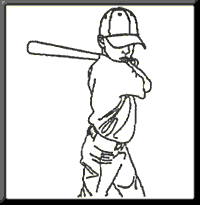|

|
Youth Baseball: Six Simple Steps To A Perfect Swing Teaches
Young Baseball Beginning Players the 6 basic elements of the perfect baseball swing.
Great material for teaching beginners.
Proper instruction and repetitive practice
are vital for young players to learn a perfect swing. The instructing coach or parent should make sure to cover each step
adequately before preceding to the next step. The parent or coach should always teach and emphasis the correct desired fundamentals.
Consideration should be given to the fact that young players learn at different rates and have varying attention spands. Some
young players
learn the proper techniques more rapidly than others. However, with proper instruction, practice and a patience
instructor , every child can learn and master the skill of hitting. Every child can reach his potential as a player and experience
fun and success! Good Luck and Happy Hitting!
Coach Nick Dixon
|
|
"The 6 Basic Steps
To Teaching A Perfect
Swing"
Step 1 - Using a "Good Grip"
Using the proper grip allows the batter to achieve as much hand
quickness and bat speed as possible. The key to a good grip is positioning the bat in the fingers and not the palms. The bat
should be held firmly but not tight that the batter's hand speed is slowed. The batter can assure a great grip every time
by lining up the "door knocking knuckles" as shown.


|
|

Step 5 - Head Action and Ball Tracking
The batter should turn his head enough that he can see the ball
with both eyes. The "IKE to MIKE" method should be taught. The batter,s front shoulder, toward the pitcher, is "IKE", and
his back shoulder is "MIKE". The batter should start with his chin on "IKE". During the swing the head does not move. The
body rotates and the shoulders switch places with the head finishing on "MIKE". The batter should keep his eyes on the ball
and should be taught to "track" the ball from the pitcher's hand to the bat.

Material contributed by Hit2win.com.
Author
- Coach Nick Dixon
Nedco Sports Products, Inc.
| |
 |
|
By "Coach Nick"
Nedco Sports Products,
Inc.
Baseball2U.com

Step 2 - Have a "Super Stance"
The batter should always be taught to use a balanced parallel
stance with both feet about shouolderwidth apart with his toes even and slightly facing inward. He should assume his stance
about 8-10 inches from the plate. The batter should slightly bend his knees with his weight on the balls of his feet. The
batter's front shoulder, hip and knee should be slightly turned forward. A proper stance will allow the batter to react to
the pitch with speed, quickness and power.
Step 3 - Correct Hand, Arms and Bat Angle
The bat is correctly held at a 45 degree angle. The hands should
not be held too high or too low. A medium location is desired with the back elbow down and the hands located 3-6 inches from
the body. The bottom of both elbows should be parallel. To assume the most comfortable stance the batter should position his
arms and hands so that the upper edge of the top of the hands on the bat is even with the shoulder.
|
|
Step 4 - Four Keys to a Correct Stride
1.The batters stride should be short, no more than two or three
inches.
2.The stride should be at a 45 degree angle towards home plate.
3.The batter should land softly on his front
foot as if he were stepping on an egg.
4.The batter should stride and land on the big toe or inside of his front foot.

Step 6 - Swing and Finish
The batter should take a good level swing or slightly downward,
He should strive to keep his back foot in position while lifting his heel slightly and then turning his foot towards the pitcher
as he starts his swing. He should concentrate on hitting the "top-half" of the baseball. When his front foot lands, he should
thrust or turn his hips. | |
|

